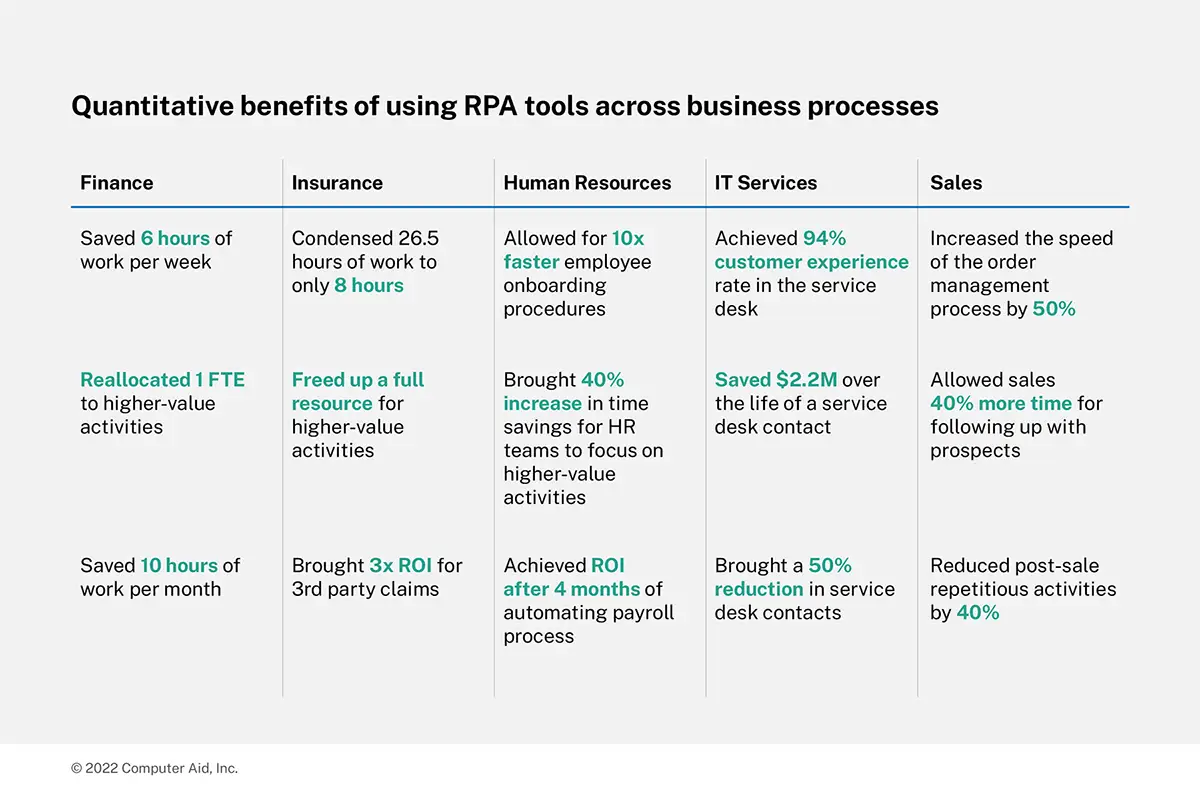Robotic process automation (RPA) tools have emerged as one of the go-to solutions for businesses under pressure to refine their outdated IT infrastructure and remain competitive.
Reasons?
It helps automate high volume, rule-driven, and repeatable activities and shifts resources to more effective processes. According to Pegasystems survey, 63% of global executives believe that RPA is a significant component in digital transformation, while 23% think it’s the most important component.1
What are robotic process automation tools and how do they work?
RPA tools perform "if, then, else" statements on structured data, typically using a combination of user interface (UI) interactions. RPA tools connect to APIs to drive client servers, mainframes, or HTML code.
These RPA automation tools operate by mapping a process in the RPA tool language for the software "robot" to follow, with runtime allocated to execute the script by a control dashboard.
At present, process automation tools are available in three variants:
- Attended automation tools: These tools require human input and monitoring during the automation process.
- Unattended automation tools: These tools have their own intellectual power and decision-making capabilities and don’t require manual intervention.
- Hybrid automation tools: These robotic process automation tools have the combined capabilities of both attended and unattended RPA tools.
How does robotic process automation help organizations?
Robotic process automation tools are non-invasive, meaning they don’t necessarily require integration with the legacy systems to act at full potential. They can act as silos, and be rapidly deployed to accelerate the pace of a digital transformation initiative. This is ideal for automating workflows built on legacy systems with no APIs, virtual desktop infrastructure, digital mediums, or database access.

RPA tools have the potential to help enterprises connect all the dots of process and integration quickly and efficiently. Once implemented, these tools help to streamline workflows and allow organizations to be more flexible, responsive, and profitable. RPA also boosts employee experience with better work scoping and engagement, improved technical expertise, and increased productivity. These benefits translate to the customer experience, as well.
What is the fundamental need for an RPA tool deployment?
The fundamentals are simple. A successful RPA deployment requires a detailed understanding of framework creation, planning, and execution. And most importantly, a dedicated team that understands the requirements and process inside-out is essential. It’s also important to weigh the proportion of human and digital interventions needed during the deployment to bring the right automation outcomes.
The success of robotic process automation tool implementations is based on effective follow-up and usage across all levels and hierarchies of the organization. If a proper end-to-end automation program is built and deployed, it enables enterprise resilience and agility. Automated tools can incorporate changing business and customer requirements seamlessly, and constantly update processes and deliverables for sustainability.
Undoubtedly, the positivity and faith in the RPA solution are cemented only when results are tracked and reported. The C-suite and the leadership teams (an integral part of RPA automation tool implementers and adopters within the organization) look for quantitative metrics like time saved, relocation of low-value manual tasks to digital workers, cost efficiency, and data-driven, strategic decision making.
Additional reading: How Amerisure Insurance used RPA to achieve a 3X ROI
How to shortlist the right RPA tool or vendor
While selecting an RPA tool, organizations must prioritize and emphasize its capabilities, and sync with the business requirements, efficiency, and pricing that are right for their business. Supplier analysis should be well researched once an understanding of the business objective and RPA requirements are shared and agreed upon. Below are some of the suggestions which can form a checklist for your selection and decision-making process.
Some of the major components/selection criteria should include:
- Adherence to business requirements
- Updated with industry-specific trends and development
- Platform independence
- User-friendliness
- Smartness in terms of the end-user role
- Cost to implement and maintain
- Scalability
- Maintenance and support services offered
- Pricing and subscription options
- Free trials/pilot projects availability
In terms of capabilities, robotic process automation tools include 3 mandatory capabilities. They are:
- Integrating and communicating with the existing legacy system (either through screen scraping or API integrations)
- Decision-making capabilities
- Interface for a bot programming
Concluding thoughts
Without RPA, there is a lot of potential in the workplace that goes unused. RPA enables employees to identify areas that need improvement and unleash the organization's full potential with end-to-end automation and the integration of software robots. Robotic process automation tools assist organizations in upping their business game and allocating resources in the most optimized manner.
At CAI, we have helped many organizations automate their processes with intelligent automation /RPA and increase their ROI. View our quickstart guide to see how RPA adds value to specific industries or fill out our form below to speak with an expert about automating your business processes.
Endnotes
- “Survey Reveals Biggest Benefits, Challenges to RPA Solutions.” Pega, September 25, 2019. https://www.pega.com/insights/articles/survey-reveals-biggest-benefits-challenges-rpa-solutions. ↩



